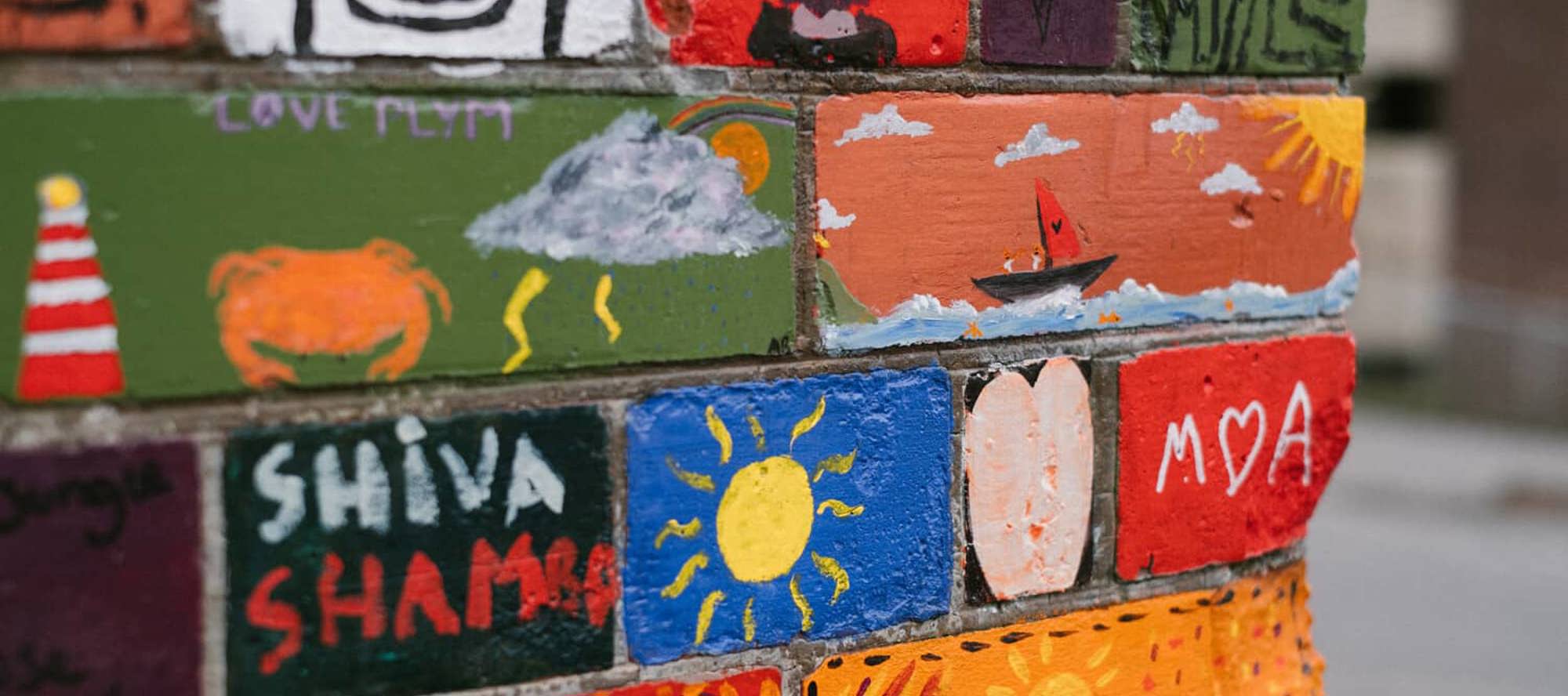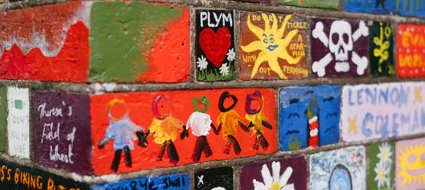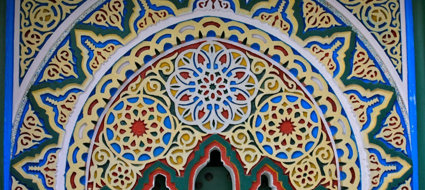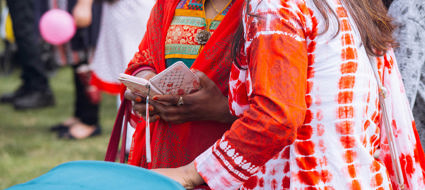Identity needs of minoritised children and young people in care
Published:
This podcast highlights key messages from recent research exploring the identity needs of minoritised children and young people in care. The discussion focuses on the dynamic nature of identity and how practitioners can explore what ethnicity and religion means to children and young people.
Part of Expressions of self: supporting minoritised children’s identity - open access learning resources.
This podcast is a conversation between Julie Wilkinson, Senior Research and Development Officer at Research in Practice, and researchers from the Centre of Trust, Peace and Social Relations at Coventry University, Sariya Cheruvallil-Contractor, and Kusha Anand.
The podcast includes a discussion of key messages from recent research with minoritised children and young people in care carried out by the team at Coventry and funded by the Nuffield Foundation. The discussion highlights the dynamic nature of identity, the importance of lived religion and what practitioners can do to remain child-led when discussing identity.
Talking points
This podcast looks at:
- Why the identity needs of minoritised children is an important area of research.
- The creative methods used in the research and the wellbeing and emotional safety of research participants.
- The dynamic nature of identity and implications for practice.
[Introduction]
This is a Research in Practice podcast, supporting evidence informed practice with children and families, young people, and adults.
Julie: Hello, and welcome to this podcast. I'm really pleased to have with me two researchers from Coventry University, who have been doing some fascinating research, funded by the Nuffield Foundation, on supporting the identity needs of minoritised children and young people in care. So, without further ado, I'm going to hand over and ask the colleagues to introduce themselves, starting with you Sariya.
Sariya: Thank you so much Julie, it's really great to be here. My name is Sariya Cheruvallil-Contractor and I'm a professor in the Sociology of Children at the Centre for Trust, Peace and Social Relations, Coventry University. Absolutely delighted to have done the research funded by the Nuffield Foundation on Children in Care and their identities and actually, really pleased to have the opportunity to talk about the work with you today.
Julie: Thank you, Sariya. And Kusha?
Kusha: Thank you, Julie. I'm Kusha. I'm a Research Fellow and Co-Investigator on two research projects at the University of Coventry. I have a decade of previous experience in inter-disciplinary projects, focussing on ethnic minoritised groups, refugees and migrants in the UK. I'm very passionate about the use of art-based methods to amplify the voices of children from these groups in the UK. Very nice to be here.
[Why the identity needs of minoritised children is an important area of research]
Julie: Thank you. Thank you both. And I just want to say that there is a third member of the team, Alison Halford, who isn't here today but is a key member of the team and of this part of the research. So, Sariya, if I could come to you first. I wonder if you could just tell the listeners a little bit about the research and what some of the key messages coming out of the research are? So, just a little taster of what's to come.
Sariya: Thank you, Julie. So, me and Alison and Kusha, we've been working in this area around children from minoritised background, their identities, for a good few years now and what we've realised was that there is a gap in research around children and their identities and this gap was all about children's voices actually missing from the debate. Children's voices missing from discussions about identities and that is what we tried to address in our work. So, we spoke to 26 children of Black, South Asian and other minoritised backgrounds. These children and young people were in the age range of fourteen to twenty-one. We spoke to them about what ethnicity and ethnic identity meant to them. Many of these children had religious identity as well and so we spoke to them about what religion, spirituality or a lack of religion, what did it mean to them in their lives? And our work was about translating these children's narratives into resources, into tools that for the people who work with them, you know, social workers, foster carers, decision makers, others, who work with these children... wanted to create tools and resources that they could use to better serve these children.
I think a key finding from our work has been that children's identities are not really set in stone. They're changing each time, they're changing depending on the context they live in. It could be the schools they are going to or the foster carers they live with. It's changing with time depending also on wider circumstances and then we brought all of this together, this changeability of children's identities. We brought it together into a concept called influx identities that we will be talking about later on in this podcast, but I think that is really the biggest message. Often when it comes to identity, we look at it through adult lenses. This is what Blackness means or this is what being a Christian means or this is what a Muslim means. Whereas, when we spoke to children, they had their own ways of understanding these identities, of living through them and the meaning that this quote, unquote, labels had for children, can be very different from how us adults would define these labels. And that's another really key finding of our work. Listening to children, active listening. No two children's version of Blackness is going to be the same and underpinning all our work, both methodologically as well as in the resources we provide and produce, is this commitment to really listen to the children and letting their voices shape decision making about their lives.
Julie: Thank you. That's really interesting and we'll go into a little bit more detail about the findings shortly, but before we get to that, why do you think this is an important area of research?
Sariya: So we know that, every year, around 70-80,000 children come into care. Of the children who come into care, around 15% are of minoritised backgrounds and what we know, for example, from the census 2011, we don't have the latest census results yet, but we know from census figures that consistently when it comes to people from minoritised backgrounds, they have some sort of reliance on faith and on religion. In fact, the last census told us 80% of people who come from Black and minoritised backgrounds have a commitment to faith. Now, this will be different kinds of commitment, the different kinds of faiths, but this nexus between ethnicity and religion is something that is not really spoken about, not really looked at in relation to children in care. Over the last decade or so, there has been a growing emphasis on children's ethnic identities. Other than our work, religion does not really form part of the evidence base that informs practice with these children. So that was one reason why we really wanted to do this work.
The other reason I think I'd describe it as, sort of, the politics of care. Our children need safe, secure and loving homes. This is the basis of all children's social work practice and within this, we are also meant to look out for their identity needs and our work, I think, goes to the very heart of what these identities entail. At the most basic level, for Black children, this could mean support for their hair and skincare needs, which on the one hand, we might take as really trivial, but if you are a Black child, in care living in a home where other people don't have hair and skincare needs like yours, this can be at the front of your identity needs. So, Muslim heritage children, the very basic needs would be things like access to Halal food, for example. For a devoutly practising Christian's child, it might mean access to Religious Education. And if you are a Christian child who's come here from another country, then it might also mean access to Christian Education, to Christian scripture in a language which you are familiar with. Our work is all about this intersectionality, the intersection between very basic identity needs, the intersection between ethnicity and religion, but also being a minoritised child in care and actually, I'll take that a step further, actually it is being a child in care, because all children, irrespective of their ethnicity or their identity needs. And our work is about encouraging all families and practitioners to pay particular attention to these needs.
Now, I've spoken about basic needs, right? I've spoken about Halal food, I spoke about skincare and hair care, I spoke about access to scripture in a language that you are familiar with. Now, if our colleague Alison were here, she would have also spoken about the Halal principle, but I'll try to channel my inner Alison. And what she means by the Halal principle is that every time we've spoken to practitioners who are working with a Muslim child, they say “We'll meet this child's needs by giving them Halal food.” Now, this could be transposed to a different ethnicity, to a Black child. I mean here from practitioners that if we had a Black child in our care, we would support them by ensuring they have access to adequate hair and skincare. These are absolutely essential things. But, when it comes to identity, it is much more than just these kinds of things, but it is also about the bigger picture. What is your version of Blackness or what is your version, what is each child's version of Islam or of Blackness or of whatever aspect of their identity they seek to prioritise? What are the bigger questions around identity? So, Blackness could be about hair and skin. It is also about Black culture, Black music, Black homes of worship. Through our work, we really wanted to cover how do children understand these categories? Not through adult lenses, but through a child's lens and that is why I think this work is really important. Prioritising, emphasising, amplifying the child's voice in discourses that heretofore are really determined by adult lenses, but also on discourses that are so politicised by social hierarchies and whose voice is heard more. We wanted to deconstruct some of these categories. We wanted to disrupt some of these social societal hierarchies by amplifying the child.
[The creative methods used in the research and the wellbeing and emotional safety of research participants]
Julie: I wonder, Kusha, if you could just talk a little bit about the research that you did, because this is obviously quite a sensitive piece of research, so can you just talk us through the methods that you used.
Kusha: Yes, Julie. So, we did this research with a very wide print tapestry of research methodologies, all with a goal of truly connecting with our participants in the context of their unique stories and we travelled this part as a bit of a mosaic of methods combining art, collaboration and a key focus on children's voices to reveal a rich, nuance understand of the expressions of identity. And we are not just talking about traditional paintings here. We're talking about a symphony of creative outlets, such as art, carpentry, interior décor, drama, poetry, photography and yes, even TikTok. So, this mixture empowered and amplified our participants' voices to convey and to share their journeys authentically and in their own methods of preference, going beyond the constraints of the traditional research methods. Also, in our research, managing power differentials also became critical and acknowledging and addressing these power dynamics wasn't just a check box for us. It was the key to creating an environment or atmosphere or safe space for a participant to feel free to express themselves and also to contribute to the research on their own terms.
Importantly, the heartbeat of this project is the participatory methods, with the spotlight on amplifying children's voices. It was mainly a journey lead by our young participants themselves, where they had the full autonomy to share their experiences in their own unique ways and in this piece, our participants didn't just contribute, they truly expressed themselves. They truly shared their expressions of identity in the ways that resonated with their own diverse stories and perspectives.
Julie: Can you give some examples of those kinds of methods that you used?
Kusha: So when we approached and when we spoke to our participants, we gave them a medium of their own preference to choose. So, for example, when I spoke to one participant they used interior décor of their rented accommodation of the council house to talk about the journeys of migration, the journeys in care in that particular accommodation. And other participants shared their TikTok account with me, to share their expressions of identities and also to share their responses to their expressions of identity when prompted by our viewers. I have another example to share with you. A young participant shared his pieces of artwork with me and he explained how each colour, how the canvas described his journeys and the colours in those artworks, were his emotions in care.
Julie: So, those kinds of methods could be used by social care practitioners in their exploration of identity with children and young people? Is that a fair assessment?
Sariya: Yes definitely, and our young participants have also shared that they were very happy to explore these methods with front-line practitioners and they found these methods more useful to share their journeys, rather than an interview from questions. They also said that the creative communication through this method, better described their expressions of identity than the pieces or the list of traditional questions.
Julie: Thank you. And talking about identity can be quite emotive for children and young people, so how did you ensure the wellbeing and emotional safety of the participants in the research?
Kusha: This was very important and our first approach was not to re-traumatise them by giving them the option of the medium of their choice, really helped us to develop the first layer of safe space for them. We used a trauma-informed approach in our research and it was important for us to understand the potential impact of trauma, including the racialised and caste-based trauma among the young participants we spoke to, was very pivotal and important to us as researchers and we did this by meticulously crafting a very safe and non-retraumatising space by navigating the challenges with strategic conversations and approaches. We were very sensitive to the interactions we had with our young participants. We made those adaptations in the recent design ensuring that the discussions we had with the children on these sensitive topics are handled and approached with cultural humility and care.
Julie: Is there anything else you'd like to add to that Sariya?
Sariya: Yes, what we realised in doing the work, that identity is something that is really complicated to talk about because of their context, because of their traumas they will have experienced, prior to coming into care. This will have coloured children's experiences, children's perceptions of practitioners working with them and they might be fearful of speaking about particular aspects of their identity or in other context, they might just not be sure, you know. Is this something I can talk about? Is this something of value? Is this something that shapes my experiences of care? And so, we found that children are really, really uncertain about what is worth asking or speaking about and may therefore not bring it up in a straightforward conversation. So, you're asking them questions. You might be writing things down. That's another thing that might bring fear into a child or a young person. You're writing something down. 'Oh my gosh, whatever I say is going to be written,' and that can really cause fear.
Whereas, where we used creative methods, you know, all the methods that Kushal mentioned, you can really get into… have some really detailed insights into a child or a young person's life. Kushal had this experience where… we all had these experiences as we went into fieldwork, children didn't really want to speak to us and they'd refer us to something else, a piece of creative writing, maybe a social media platform, a social media profile. That's when you'd really pick up these nuances. I think it's important to create these alternative ways around talking about identity.
[The dynamic nature of identity and implications for practice]
Julie: Thank you, that's really helpful. Sariya, you talked about influx identities at the start of this podcast. I wonder if you could just explain that in a little bit more detail and also, how thinking about that framework might be useful for front-line practitioners?
Sariya: So, I've introduced influx identity as a form of thinking about identity that is moveable, that is changeable with time, that is reflective of the context a child lives in, and that crucially acknowledges a child's world view, a child or a young person's world view. Now, let me give you some examples here. We have encountered, for example, Muslim children who have told us… they may well have come from a background that was deeply religious. They have retained that commitment to religiosity and some time, in some aspects of their journey through care, but they also speak about how this changes with time. Sometimes they are… on some days they are deeply, deeply religious and religion is at the front of all their decision making or their lived experiences, but later on, as time moves on, perhaps as they live with a different foster carer, something changes at school or they have a new friend and their commitment to religion changes. Similarly, we've heard from children of minoritised ethnic identities, how, you know, in certain contexts, their Black identity is, they describe it as the be and end all of who we are, we really want to prioritise, we really want to emphasise our Black identity, we want to take that deep dive into Black culture, we want to engage in anti-racist politics. But then later on, this might take a back seat, you know, they might, again, it depends on context. The other thing we've realised, as we do all of this work, and as we talk to children about identity, is who they are placed with is a big determiner of their experiences of identity. This does not mean that same ethnicity, same religion placements always create safe spaces for children and young people. For some children, it may well do, and, you know, we've come across children who thrive if they are in a same ethnicity, same religion placement. But we've also seen the nuances.
On the face of it, it might look, if you place a Black child in a Black household, it might look like a same ethnicity, a perfect match placement, but children rarely pick up the nuances, and it may well be that the child is from a Black Nigerian heritage and they're placed in a Black South African family, and these differences really shape a child's experience through care. We really want to encourage family practitioners not to think about these categories, sort of, essentialised, set in stone ways, instead, we encourage them to be asking each child, 'What is your experience of faith? What is your experience of ethnicity so far in your life? How would you like to be known? You know, how would you like to be known today? And then when I meet you again, maybe three months down the line, I want to ask you again how do you want to be known today?' So, it is really about these new answers, it is really about encouraging family practitioners to think about wider contexts and how these shape a child's perception of themselves. We've had young people, young, Black people who've been the only Black person in their school. They have been on edge, they have felt the need to perform in a particular way, and then they have moved, and now they're not the only Black person in their school, they're one of half the school is Black because of the geographical location of that area.
Does this mean that the pressures on the child are removed? Yes, in some cases, but we've seen children who've been troubled by this as well because now, it's a different kind of performance that they have to do. So, coming back to your question, what is the impact of this influx identity on everyday frontline practice for children and young people? We often get asked that question in, sort of, frontline practice contexts, and what we say is our job is not to make things easier, we're not here, and indeed, we cannot tell you what Blackness might mean, or what Islam might mean, or what Christianity might mean to a child in care. Instead, what we're here to do is to encourage you to think about each child is really, really unique as having had their own baggage, so prior to coming into care, they will have had lived experiences of identity, they bring that baggage with them, and every time they move to a different foster home, they are adding to their baggage, and just as they've got their bags of stuff and clothes and toys and memories, metaphorical bags, identity bags, and we encourage social workers to think about this and think about how it changes, and then to, you know, tailor how they meet children's needs to how children articulate themselves.
I'll give you an example, right, every time, so me and Kusha and Alison, we do a lot of work with frontline social work practitioners, we also deliver our work to, you know, communities, these might be Black communities, these might be Muslim communities, these might be Christian communities, and this is largely aimed at raising awareness about the needs of children in care. But any time they go to a Muslim community, they're often told about “Let's give these children gift boxes. Let's give these children Muslim gift boxes.” Now, firstly, I wonder how a gift box can suddenly become religious, but apparently they do, but jokes apart, and they tell us, the communities tell us “In this gift box, we will put a Quran in it, probably in Arabic, we will put some prayer beads in it.” You know, like a little rosary, it's called a Tasbih in Muslim contexts, but it's very much like a rosary, it's single beads. “We will put a prayer mat in it. If it's a boy, we might put a little prayer cap in it. If it's a girl, a little hijab or a headscarf. For fun, we might put a toy in it. But we'll think about that.” We often have to push back a little bit with Muslim communities because we have to tell them the reality of being in care means that some children might be genuinely grateful for this, they might genuinely love receiving a box with a Quran and prayer beads and a little hijab or whatever, and they might be really happy and it might do well, serve these children well in relation to their identity beads.
There will be other children who are completely flummoxed, confused, who will be, you know, completely flummoxed by the contents of the box, who won't know what to do with the prayer beads, who won't be able to recognise the Quran, because their experience of Islam so far will have been one that is perhaps a cultural Muslim identity rather than a religious identity. And then there might be some children who might be traumatised by receiving a box of this nature because they may have received ill treatment at the hands of people who were quote, unquote Muslim, some sort of trauma by people who were Muslim that led them to coming into care. And so, just as we work with Muslim communities and we push back and we say, 'Look, you've really got to think about what Islam means for a child in care.' It's the same kind of work we want to do with frontline practitioners. We've really got to understand the context of the child without imposing these labels of ethnicity or of religion or indeed, culture talks a lot about caste. Before you went imposing these labels, you've got to ask a child, 'What do these labels mean to you?' And that's the thrust of our work, we've developed tools that practitioners can read about and have a briefing to aid with having these conversations.
Julie: And I think I would strongly recommend anyone who's listening to the podcast to read the briefing and in particular to look at some of the suggestions for practice that have been made in the briefing, which I think are really, really helpful. That's really interesting to hear about this research and some really important findings coming out of it. So, is that the end of the research or is there more to follow on that links into this research, Sariya?
Sariya: Thanks, Julie. I think for this research team, this work that we've been doing is all about making a difference to society's most vulnerable children. There's a campaign going on at the moment that says, 'Being in care should be one of the, you know, nine equality strands.' Because being in care does really limit life chances, life outcomes for people with this experience. And so, for us, this is all about commitment and professional as well as personal, and trying to make things, you know, ever so slightly better for children and young people who are care experienced. Now in this regard, we have more recently had funding come through from Barnardo's, and they are really keen to translate some of our own research findings as well as research that other people have been doing. What they're keen to do is translate this into practice, into creating safe spaces within care settings where Black children in particular can feel, you know, feel able to assert who they are, and to assert their identity needs. In some ways, you know, we're very grateful to be doing this work from them because it's almost, you know, it's like it was destiny, but it's this opportunity to take the work that we have been doing separately, but to translate it again into different kinds of practice implications. So, yes, excited to be starting that work at some point in the new year.
[Outro]
Julie: Translating the findings into practice is a key area, and very, very important. So, I'd just like to thank both Kusha and Sariya for joining us, and just want to see if there are any final thoughts before we sign off.
Sariya: Julie, I think we'd like to thank you, both of us, we'd like to thank you as well as Research in Practice for giving us this opportunity to talk about our work.
Julie: No, thank you very much for all your contributions too. It's very, very valuable work. So, thank you both very much for coming, and look forward to seeing your new research coming out in due course, so thank you very much.
Thanks for listening to this research and practice podcast. We hope you've enjoyed it. Why not share with your colleagues and let us know your thoughts on Twitter. Tweet us @researchIP.
Reflective questions
Here are reflective questions to stimulate conversation and support practice.
- How can I do more to find out what ethnicity and religion means to the children I work with?
- What techniques can I use to support a child-led approach to discussing identity?
- What can I do to make sure that the care and support offered to children reflects what matters to them in terms of their ethnicity and religion?
Resources that are mentioned in this episode
- Expressions of Self: Race, Religion and Representation of care-experienced children and young people research.
- Nuffield Foundation Research Report (2024) - Expressions of Self.
Further related resources are available below.
Professional Standards
PQS:KSS - Relationships and effective direct work | Communication | Analysis, decision-making, planning and review | Developing excellent practitioners | Shaping and influencing the practice system | Developing excellent practitioners
CQC - Responsive
PCF - Diversity and equality





